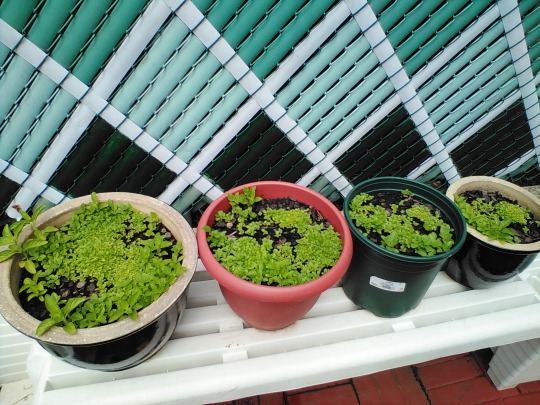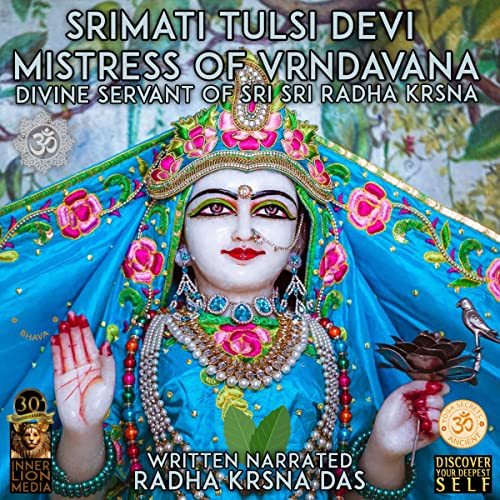#tulsi plant
Explore tagged Tumblr posts
Text

Srimati Tulasi Maharani 🌺🪴🌱
“I offer my repeated obeisances unto Vrinda, Srimati Tulasi Devi, who is very dear to Lord Kesava. O goddess, you bestow devotional service to Vishnu and you possess the highest truth.”~Pranam mantra
20 notes
·
View notes
Text
Hello friends 👋
Today marks the end of Tulsi Vivah of this year.
Tulsi Vivah is a symbolic marriage ritual between the sacred Tulsi plant and Lord Vishnu (often represented by the deity Shaligram or a Krishna idol), is celebrated with reverence and joy in Hindu households.
This occasion also marks the end of the Chaturmas.
youtube
So to conclude this day, we would like to share with you a tulsi mantra ☺

Have a good day ☺
2 notes
·
View notes
Text
IA Prep: Botany (Medicinal Botany)
Tulasi
Botanical name: Ocimum sanctum
Telugu name: Tulasi
English name: Holy basil
Sanskrit name: Vrinda
Family: Lamiaceae
Morphology: Erect, highly branched, softly pubescent aromatic sub shrub/annual herb.
Leaves range from elliptic to oblong, flowers white to purple, fruits are ellipsoidal nutlets - carcerulus.
Useful parts: The entire plant, especially the essential oil extracted from the leaves.
Chemical constituents: Eugenol (70%), Methyl eugenol (20%), Carvacrol (3%), Caryophylene (1%)
Uses:
- Antibacterial
- Insecticidal
- Diaphoretic (induces perspiration)
- Expectorant (clears lungs from excess mucus)
- Carminative (prevents formation or facilitates expulsion of gas)
- Treats Catarrh (excessive discharge of mucus in the nose and throat due to inflammation of the mucous membrane)
- Treats cough, cold, gastric disorders, etc.
- Treats snake bite and scorpion sting.
----------------------------------------------------------------
Turmeric
Botanical name: Curcuma longa
Telugu name: Pasupu
English name: Turmeric
Hindi name: Haldi
Sanskrit name: Haridra
Family: Zingiberaceae
Useful Part: Rhizome
- Primary rhizome: Oblong and ovate, often called bulbs or round turmeric.
- Secondary rhizome: Cylindrical long, branching, tapering at both ends. Commonly called fingers.
Used as raw material, subjected to further processing.
Has a characteristic pungent odor and bitter taste.
Chemical Constituents: Curcumin provides the distinct yellow color, three analogs have been detected so far: Curcumin I, Curcumin II, Curcumin III.
The volatile oil contains monoterpenes and sesquiterpenes like zingiberene, turmerone, borneol and cineol.
Uses:
- Antiseptic
- Astringent (tightening of soft body tissues)
- Carminative (prevents formation or expulsion of gas)
- Blood purification
- Treatment of Cough, Cold, Skin Diseases, Jaundice, and Menstrual Cramps.
Spice
--------------------------------------------------------------------
Ayurveda




--------------------------------------------------------------------
Homeopathy





--------------------------------------------------------------------
CIMAP



#exam season#send help#biology#notes#science#botany#plants#plant biology#plant science#medicine#medicinal plants#medicinal herbs#ayurveda#ayurvedic#homeopathy#tulsi plant#turmeric#please help#bad handwriting#holy basil
3 notes
·
View notes
Text


A couple of pics of my Tulsa Devi Plants
5 notes
·
View notes
Text
What Supplements Lower Cortisol and Reduce Stress?
Stress is a human experience, but it is our physical reaction to it that dictates everything. Stress, when a prolonged condition or improperly resolved, can have adverse health consequences, e.g. by increasing the concentration of cortisol. Cortisol is known as the "stress hormone" and despite the physiological importance of cortisol, chronically elevated cortisol is associated with a wide number of deleterious effects, including anxiety, obesity, sleep problem and immune dysfunction.
In fact, from all the types of supplements, it is possible to mix also to restore the homeostasis of cortisol and the stress, not only on a physical level, but on an emotional level, as a way to cope with the physical and emotional load of everyday stressors. In this article, we’ll explore some of the most effective supplements known to reduce cortisol and promote relaxation.

Understanding Cortisol and Stress
It is now important to characterize what cortisol is and how cortisol works in the body. Cortisol is an adrenal gland hormone secreted during a stress response as part of the body's "fight or flight" response. When exposed to a physiological or psychomotor stress, the body is activated by the release of the stress hormone cortisol and by its preparation to respond to the stress. This is done by elevating heart rate, blood pressure, and blood glucose.
Yet, if cortisol is chronically elevated (i.e. due to prolonged chronic stress), several of the following health conditions can result:
Weight Gain: Especially around the abdomen.
Sleep Disruptions: Cortisol controls the sleep-arousal cycle and exacerbates insomnia.
Compromised immune system: Associated chronic stress has been reported to suppress immune response and thereby elevate the risk of infection.
Digestive Disorders: Cortisol may aberrantly regulate the digestion and this can produce symptoms, i.e. bloating or constipation.
Mood Disorders: Elevated cortisol levels correlate with anxiety and depression.
The only counter to those effects is to keep cortisol at bay, in order to return to the highest possible degree of equilibrium and serenity.
#cortisol#stress#gaining weight on purpose#digestive issues#sleep disorder#ashwagandha#rhodiola#magnesium#tulsi plant#b vitamins#fish oil#health & fitness#nutrition#healthy food#fitness#vitamins#antioxidants#hydration#workout#skin health#gym
0 notes
Text
Tulsi Gabbard’s nomination as national intelligence director advances in key Senate committee vote – live

#bmw#city#tulsi gabbard#tulsi plant#japan#nature#jujutsu kaisen#motorcycle#luxury car#free palestine
1 note
·
View note
Text
Tulsi Pujan Diwas Ki Hardik Shubhkamnaye

1 note
·
View note
Text

#tumblr photographer#tumblr photo blog#tumblr art#nature photography#pixel art#artists on tumblr#phone photography#pixel photography#pixel aesthetic#desi tumblr#my photos#my phone pics#my photgraphy#tulsi plant#desi post#urban photoshoot
0 notes
Text
youtube
0 notes
Text

Embrace the sacred essence of nature with every dried leaf of Tulsi – a symbol of purity, health, and divinity. 🌿
0 notes
Text
0 notes
Text

TULSI KANTHI MALA
With great spiritual and cultural significance, the Tulsi Kanthi Mala is a sacred necklace crafted from the wood of the Tulsi plant (Ocimum sanctum) in Hinduism. Loved for both its therapeutic and spiritual qualities, Tulsi is thought to be the earthly embodiment of the goddess Tulsi, who was Lord Vishnu's beloved companion.
Many benefits, such as spiritual protection, physical and mental purification, and increased devotion, are said to come from wearing a Tulsi Kanthi Mala.
The mala typically consists of 108 beads, symbolizing the 108 Upanishads, although variations exist. These beads are intricately strung together, often with a larger bead known as the "Meru" bead, signifying the start and end of the mala.
Apart from its spiritual significance, Tulsi Kanthi Mala is believed to have healing properties. Tulsi is renowned for its antibacterial, antiviral, and anti-inflammatory qualities, which can contribute to overall health and well-being. The Tulsi Kanthi Mala is essentially more than simply a piece of jewellery; it represents faith, dedication, and the enduring bond between the wearer and the holy.
0 notes
Photo

Tulsi Devi - Mistress Of Vrndavana: Divine Servant Of Sri Sri Radha Krsna https://barnesandnoble.com/w/tulsi-devi-mistress-of-vrndavana-radha-krsna-das/1142541017…
#Tulsi Devi#tulsi plant#vrndavan#ISKCON#Krishna#Srimati Radharani#Srimad Bhagavatam#Radha Krishna#GOLOKA VRINDAVAN
2 notes
·
View notes
Text

Rooted in Tradition Crafted with Love | Maia Bespoke
Rooted in Tradition, Crafted with Love
Maia Bespoke Stone Arts draws inspiration from the timeless wisdom of Indian culture, where the sacred Tulsi plant symbolizes growth, harmony, and balance.
Like the Tulsi, our artisans nurture each stone with devotion and care, shaping beauty that transcends time.
Experience the fusion of ancient traditions and modern artistry, as Maia Bespoke Stone Arts brings you exquisite pieces that resonate with the soul.
#MaiabeSpokeStoneArts#architecture#art#stone art#stone#tulsi plant#StoneArt#handcraftedwithlove#Indian Culture Inspired
0 notes
Text

Tulsi, or holy basil, is an herbal plant that is used for the treatment of various health problems. It is one of the herbs used in alternative medications like Ayurveda for its immense therapeutic effects. Tulsi is rich in antioxidants and has anti-inflammatory properties which can help in treating colds, coughs, and respiratory infections. It is also known for boosting the immune system, improving digestion, and also reduces stress levels. There are other benefits of tulsi, such as helping in purifying the blood, curing insect bites, lowering blood pressure, treating respiratory disorders, maintaining blood sugar levels, reducing stress, maintaining dental health, treating kidney stones, and many more. Tulsi is a fantastic medication that helps in treating various health issues.
Credit source:https://vedicarehealth.com/
#health#healthcare#healthandwellness#bodypaincause#mental health#stayhealthy#vedicarehealth#tulsi plant
0 notes
